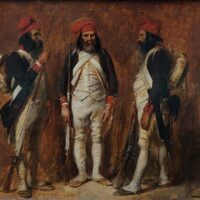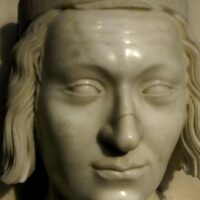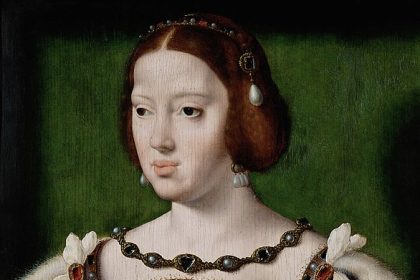Founded in 962 by Otto I, the Holy Roman Empire was a political union of states in Western and Central Europe (initially the kingdoms of Germany, Italy, and Burgundy). Built on the ruins of the Carolingian Empire, it emerged from the desire to resurrect the Western Roman Empire, which had fallen in 476. Spanning from the end of the Early Middle Ages to the beginning of the modern era, this complex entity evolved significantly over the centuries. Under the reign of Charles V, the religious unity of the Holy Roman Empire was shattered by Martin Luther’s Protestant Reformation. This led to religious conflict, culminating in the devastating Thirty Years’ War.
- Who Founded the Holy Roman Empire?
- What Are the Dates of the Holy Roman Empire?
- What Was the Empire Like During the Middle Ages?
- How Was the Empire During the Modern Era?
- What Was the Constitution Like Under the Holy Roman Empire?
- What Were the Flags and Symbols Related to the Holy Roman Empire?
- What Did Charles V Do During the Holy Roman Empire?
- What Were the Consequences of the Holy Roman Empire?
- Key Dates of the Roman Empire
After losing much of its influence, the elective monarchy did not survive the Napoleonic Wars. Facing Napoleon Bonaparte, Francis II renounced his title as Emperor of the Romans. On August 6, 1806, after more than 800 years of existence, the Holy Roman Empire disappeared. It left behind a cultural and political legacy shared by many modern countries. This period is also known as the First Reich.
Who Founded the Holy Roman Empire?
When the Western Roman Empire fell in 476, it was replaced by a multitude of barbarian kingdoms. In Gaul, Clovis I founded the Kingdom of the Franks, which quickly expanded toward Central and Southern Europe. The Carolingian dynasty succeeded the Merovingians, with Pepin the Short ascending to the throne in 751. Under his son, Charles I, known as Charlemagne, the Carolingian Empire reached its peak. Determined to revive the ancient Roman Empire, the King of the Franks embarked on a campaign to conquer Europe.
By the end of 800, the monarch was crowned Emperor of the West by Pope Leo III in Rome—a first in three centuries! After the Treaty of Verdun in 843, the Carolingian Empire was divided among three of Charlemagne’s grandsons. Charles the Bald inherited West Francia (the future France), Louis the German received East Francia, and Lothair was given Middle Francia and the imperial title. This marked the end of Charlemagne’s unified empire, which officially ceased to exist in 924 after the assassination of Berengar I. The imperial title remained vacant until the coronation of Otto I, King of Germany, who created the Holy Roman Empire in 962.
What Are the Dates of the Holy Roman Empire?
A political union of states in Western, Central, and Southern Europe, the Holy Roman Empire lasted from 962 to 1806, disappearing at the dawn of the modern era. Initially, the Holy Roman Empire encompassed territories of the former East and South Francia, including the Kingdom of Germany, Bohemia, and Italy. By 1032, the Kingdom of Burgundy had joined the empire. Modeled after Charlemagne’s empire, Otto’s dream was to restore the Roman Empire on the remnants of the Carolingian realm.
At its height, it covered much of Central Europe, including modern-day Germany, the Netherlands, Belgium, Luxembourg, Switzerland, and parts of France and Italy. By the 18th century, however, the regional influence of the Holy Roman Empire had waned in favor of Prussia. It finally collapsed during the Napoleonic Wars. After the signing of the Confederation of the Rhine treaty, Francis II renounced his title as Emperor of the Romans on August 6, 1806, marking the end of the First German Reich.
What Was the Empire Like During the Middle Ages?
The Ottonian dynasty ruled the Holy Roman Empire from 962 until the death of Henry II in 1024. During this period, the empire prospered, developing a thriving merchant economy. Close to the Church, Otto and his descendants dreamed of uniting all of Christian Europe under one empire. To strengthen their authority, they ensured the loyalty of many bishops through the “imperial clientele” system. Christianity played a central role in the Holy Roman Empire during the Middle Ages.
The Church was a privileged partner of the rulers and formed the backbone of the imperial administration, serving as a counterbalance to secular powers. The Ottonians were succeeded by the Salian dynasty, which reigned from 1027 to 1125 and worked to preserve peace. With the decline of the Hohenstaufens in the 13th century, central authority weakened, while the power of the prince-electors grew. By the end of the Middle Ages, the Holy Roman Empire had shrunk to mainly German territories and abandoned its universal ambitions. In 1452, the imperial title passed to the House of Habsburg.
How Was the Empire During the Modern Era?
Under the reign of the Habsburgs, the Holy Roman Empire experienced a revival and regained influence. In 1495, Maximilian I undertook a profound reform of the elective monarchy. Between 1517 and 1570, the empire faced Martin Luther’s Protestant Reformation, which tested its unity. The Peace of Augsburg, signed on September 25, 1555, suspended hostilities between Catholic and Protestant states. At the end of the 16th century, the process of confessionalization began, which solidified the divide between Lutheranism, Calvinism, and Catholicism.
In 1618, tensions between the two camps escalated, marking the start of the Thirty Years’ War. The conflict ended with the signing of the Peace of Westphalia on October 24, 1648. Ratified by the various belligerents, these treaties deeply reshaped the political and religious balance across Europe. From 1740 onward, Prussia and Austria emerged on the European stage, and their rivalry intensified. In the face of these rising powers, the Holy Roman Empire gradually faded, continuing its inexorable decline…
What Was the Constitution Like Under the Holy Roman Empire?
The Holy Roman Empire was governed by a set of laws and customs, many of which were inherited from the Middle Ages. Over the centuries, the elective monarchy established a number of institutions to ensure its functioning. Among them were the Imperial Diet, the Imperial Circles, the Imperial Chamber Court, the Aulic Council, and the Imperial Estates. These entities designated the individuals and corporations eligible to sit in the Imperial Diet.
The constitution of the Holy Roman Empire was largely based on written and unwritten legal foundations, some of which held the status of fundamental laws. This was the case with the Golden Bull of 1356 and the Diet of Worms in 1495. Other examples include the Peace of Augsburg in 1555 and the Peace of Westphalia in 1648. In the modern era, despite his status, the King of the Romans held little actual power. To implement effective policies, he had to collaborate with the seven prince-electors, who had the privilege of electing the emperor. These electors would play a major role in the empire’s politics until the end of the Thirty Years’ War.
What Were the Flags and Symbols Related to the Holy Roman Empire?
Upon his coronation in 962, Otto I adopted the eagle as his emblem, a symbol of imperial power dating back to the Roman Empire. However, it wasn’t until the 12th century that the eagle truly became the figure of the elective monarchy. It was replaced by a double-headed eagle in the 14th century, which soon became the dominant figure in imperial heraldry. The most famous flag of the Holy Roman Empire featured a black eagle on a gold background. During the Crusades, this was often accompanied by a red flag with a white cross.
Many cities adopted the eagle symbol in their coats of arms, signifying the allegiance of their population to the emperor. In addition to these heraldic symbols, the elected sovereign also had a collection of ceremonial regalia: the imperial regalia. Among these consecrated objects, some dating back to Charlemagne, were the imperial crown, the scepter, and the imperial orb. Other notable items included the Holy Lance, the sword, the imperial blade, and the coronation mantle.
What Did Charles V Do During the Holy Roman Empire?
Charles V, often known as Charles Quint, was emperor of the Holy Roman Empire from 1520 to 1556. King of Spain from 1516, he inherited the possessions of the Habsburg family upon his father’s death. He became the most powerful monarch of the first half of the 16th century. His reign was marked by wars against Suleiman the Magnificent’s Ottoman Empire and against France, under Francis I. However, he primarily had to deal with the Protestant Reformation, which threatened to fracture the unity of the Holy Roman Empire.
In the spring of 1521, he condemned Martin Luther at the Diet of Worms. This did not prevent a religious war that lasted until the Peace of Augsburg was signed on September 25, 1555.
This treaty ended hostilities between Lutheran and Catholic states and officially recognized the presence of Protestantism in the empire, signaling the end of religious unity. Faced with this bitter failure and setbacks against both France and the Ottomans, Charles V abdicated in 1556. He handed over his imperial title to his younger brother Ferdinand I and retired to Spain.
What Were the Consequences of the Holy Roman Empire?
The dissolution of the Holy Roman Empire during the Napoleonic Wars reshaped the geopolitical map of Europe. On July 12, 1806, sixteen German states founded the Confederation of the Rhine and seceded. After the Congress of Vienna in 1815, these states regrouped into the German Confederation. Some, primarily those established by Napoleon Bonaparte, were dissolved, allowing Prussia to gain territories. Prussia then emerged as a major power in Central Europe, eventually leading to the formation of the German Empire in 1871.
Before relinquishing his title as Emperor of the Holy Roman Empire, Francis II became Emperor of Austria. This decision led to the creation of the Austro-Hungarian Empire in 1867, which, like the German Empire, disappeared after World War I. Over nearly 1,000 years of history, the Holy Roman Empire left behind a significant political and cultural legacy. This common heritage, shared by many current nations, remains an integral part of the European construction.
Key Dates of the Roman Empire
September 4, 476 – Fall of the Western Roman Empire
Since 455, the Roman Empire has seen a chaotic succession of emperors due to coups. After assassinating Julius Nepos, General Orestes places his son, Romulus Augustulus, on the throne. Less than a year later, the young boy is deposed by the barbarian leader Odoacer. Unlike his father, who is executed, the boy is spared and exiled. Odoacer, then king of the Heruli, becomes the new ruler of Italy. After a slow decline, the fragmented Western Roman Empire, which had been weakening since the 4th century, disappears on September 4, 476.
843 – The Belgian territory divided by the Treaty of Verdun
Following the treaty, the territory is divided between Francia and Lotharingia. Flanders in the north goes to Charles the Bald, while Wallonia is integrated into Lothaire I’s territories. However, these lands will later be part of the Holy Roman Empire a few years later.
February 2, 962 – Otto I crowned emperor
In peril due to the powerful Roman aristocratic families, the Papal States once again require external assistance. Otto I of Germany comes to their aid and is crowned Emperor of the Romans by Pope John XII in exchange for his protection. From that moment, the Papal States fall once again under imperial control. Otto I becomes the first ruler of the Holy Roman Empire, a territory that includes both Germany and Italy.
January 25, 1077 – Henry IV confesses at Canossa
Amidst the Investiture Controversy, Henry IV, King of the Romans, travels to Canossa to kneel before the pope and beg for forgiveness. Having been excommunicated the previous year, his legitimacy as emperor is threatened by rebellious German princes. He waits for three days for the pope’s response, who finally agrees to lift the excommunication.
Humiliated, Henry IV soon embarks on a campaign to conquer Rome and is excommunicated once again.
February 11, 1229 – Frederick II signs the Treaty of Jaffa
To honor his promise to the pope, Frederick II, emperor of the Holy Roman Empire, embarks on the Sixth Crusade in 1228. Very brief, it ends with the signing of the Treaty of Jaffa on February 11, 1229. Sultan Al-Kamil returns Jerusalem, Bethlehem, and Nazareth to the Italian ruler. In return, Frederick agrees not to take control of Islamic holy sites.
On March 18, 1229, Frederick II crowns himself King of Jerusalem before returning to Europe. His methods provoke hostility from parts of Christendom.
July 17, 1245 – Pope Innocent IV deposes Frederick II
While the struggle between the Papacy and the Holy Empire continues, Innocent IV, exiled in Lyon, convenes the 13th Ecumenical Council. In front of the assembly, he deposes the emperor of the Holy Roman Empire, Frederick II of Hohenstaufen. For several years, Frederick had been trying to assert his authority over all of Italy. The conflict grows considerably, especially in the confrontation between temporal power and spiritual authority. Following this event, Frederick II faces several revolts and conspiracies, eventually dying suddenly in 1250. His death brings an end to the struggle between the Papacy and the empire, from which the papacy emerges stronger.
January 21, 1398 – Death of Frederick V of Nuremberg
Born 65 years earlier, Frederick V of Nuremberg dies on January 21, 1398. The son of John II of Nuremberg and Elisabeth of Henneberg, Frederick V succeeded his father as burgrave of Nuremberg, Bayreuth, and Ansbach in 1357. He spent part of his life defending the Nuremberg Castle, a strategic stronghold for the Holy Roman Empire.
January 18, 1701 – Birth of the Kingdom of Prussia
After receiving Emperor Leopold I, Frederick III, then Elector of Prussia, crowns himself in Königsberg and establishes his capital in Berlin. This marks the birth of the Kingdom of Prussia within the Holy Roman Empire. When the empire falls due to Napoleon’s conquests, it is the Kingdom of Prussia that will rise to prominence, reaching its peak at the end of the 19th century and achieving German unification.
August 6, 1806 – End of the Holy Roman Empire
The Holy Roman Empire is dissolved when Francis II of Habsburg renounces the imperial crown. This empire, founded by Otto I in 962, initially encompassed the kingdoms of Germany, Italy, and Burgundy. It lost many of its territories over the centuries and could not withstand Napoleon’s conquests. Francis then takes the title of Emperor of Austria and gives his daughter, Marie-Louise, in marriage to Napoleon.









